Watering livestock can be challenging in terms of cost as well as labor. The photo above is our daughter filling livestock water buckets with a hose, a highly inefficient system. Fortunately, nature offers an alternative in the form of rainwater and storm water, which can be harvested and moved via gravity to various types of livestock watering systems, such as stock tanks, cisterns or ponds. But what if you don’t have room on an urban property for a pond?
In a storm, even a small roof can shed enough water to fill a rain barrel or two. This is enough water to supply livestock for several days, located conveniently near water troughs and dishes. The tanks could also be connected directly to an automatic watering system that is fed via pumps or passively using gravity. Follow these guidelines to ensure that the water is clean and safe to drink.
Keep It Clean: Roof contaminants, such as bird droppings and leaf litter, can make collected water unfit for animals to drink. A first flush diverter will remedy the situation. When rain begins to fall, this device automatically redirects the first wash of dirty water that enters a downspout, diverting it away from the collection container. Following the first flush, cleaner water is allowed to enter the cistern.
Examples of First Flush Diverters
Keep It Dark: Locate collection tanks out of direct sunlight to prevent algae from growing in the stagnant water. Algae grows only in the presence of light. If your tank is translucent, you will want to cover it or paint it black to keep the water and the spigot clear of algal growth.
Keep It Covered: Closed water systems prevent mosquitos from using your stored water as a breeding ground. Seal any openings with spray foam or screening.
Keep It Legal: Check with your local government to make sure that rainwater collection is allowed in your municipality. In some states, water rights belong to the government, and rainwater harvesting is not allowed or is restricted to specific uses.
State Rainwater Harvesting Laws and Legislation
Keep It Passive: In order to make it as easy and economical as possible to water your livestock, design your water harvesting system so that it delivers the water using gravity. Elevate collection tanks or dig trenches that decline from the water source down to the point in which it is dispersed to the animals. A 1% grade, or 1/8 inch per foot, is enough of a decline to transport water without the use of any pumps or mechanization.


